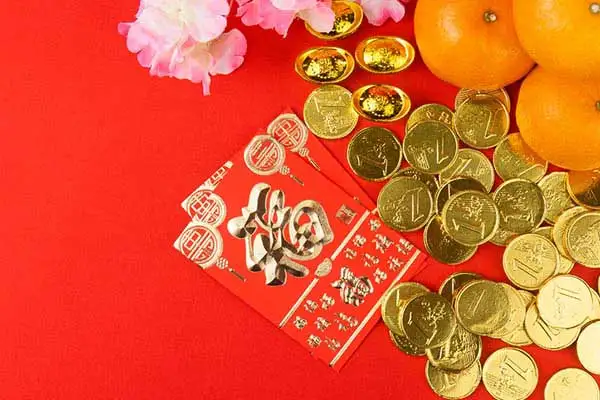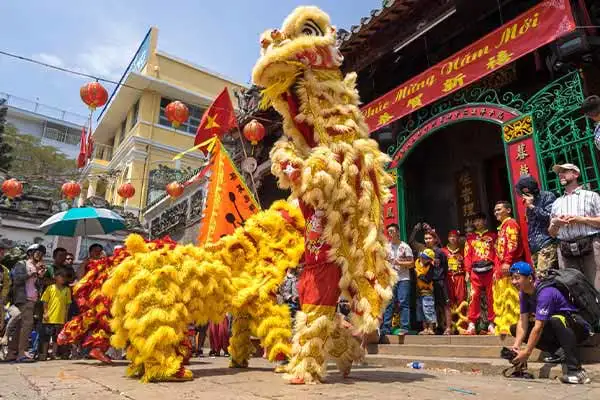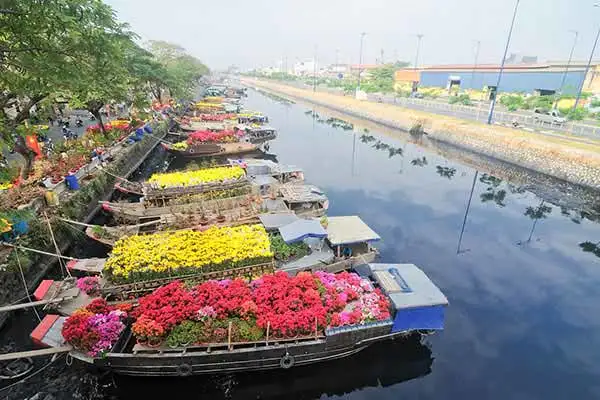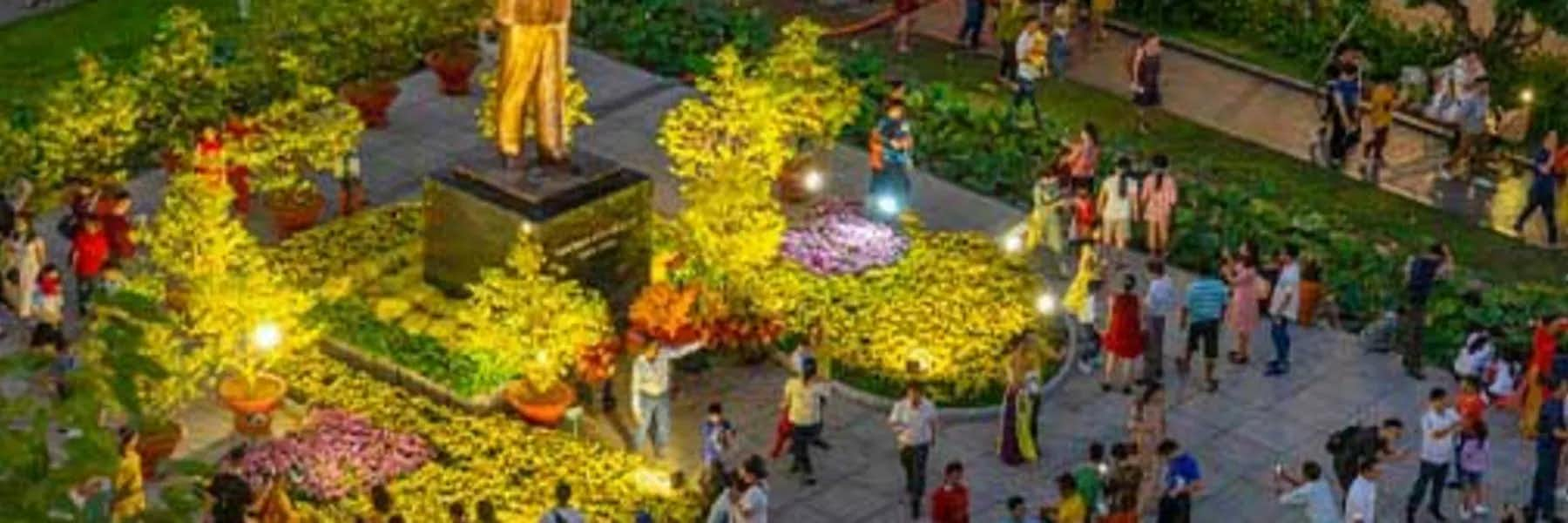The Tet holiday, Tet Nguyên Đán (“Feast of the First Morning of the First Day”) feels like a combination of New Year’s Eve, with aspects of Thanksgiving, Christmas, and Easter, all rolled up into one fabulous, frenetic weeks-long celebration. In addition to ushering in the Lunar New Year, it’s also considered every Vietnamese person’s birthday and the first day of spring.
The Tet season actually begins about two weeks before the first day of the Lunar New Year, when everyone shops for new clothes, cleans their homes from top to bottom, and strives to pay off any debts that they have accumulated over the year. They decorate their homes with kumquat trees and fresh flowers, and bring home budding, flower-laden branches to herald the arrival of spring—a profusion of delicate pink peach blossoms in the north or vibrant yellow hoa mai (Ochna integerrima) blossoms in the south.
This is also the time to stock up on little red li xi envelopes, which will be filled with “lucky money” to give to children and elders after the turn of the year. The kumquat trees, with their bright festive fruits, are the Vietnamese version of Christmas trees. The streets and markets are overflowing with shoppers stocking up with extra food and treats for Tet and the weeks after—a trend that slowly increases to a last-minute frenzy shortly before the year ends.

About a week before the end of the old year, on the 23rd day of the 12th lunar month, it’s time to make an offering to Ông Táo, the Kitchen God. Ông Táo watches over the family throughout the year and records their deeds and words. At the end of the year, Ông Táo ascends to heaven to report the family’s successes and failures to the Jade Emperor who, based on the Kitchen God’s report, determines the rewards, punishments, and luck the family will experience in the coming year. Families visit lakes or rivers to release three goldfish into the waters; the fish carry prayers to Ông Táo on their journey to heaven, and blessings are returned to those who set the fish free. Most often, the children of the household have the responsibility for releasing the fish. That evening, people burn paper offerings to help Ông Táo on his journey to the Jade Emperor. It’s a fun yet solemn beginning to the start of the holiday.
By the last day of the old year, most businesses will have closed, and will remain closed for a week or even two after Tet. The cities empty out and millions of people travel to the homes of their parents and grandparents. Everyone will gather for dinner, usually sitting on the floor on large bamboo mats laid out with a huge assortment of foods. It’s a time of happy mayhem, with children running around, the men drinking and joking, and the women doing the last-minute cooking and puttering around after the kids. Family altars are cleaned and adorned with colorful offerings for the new year; the old incense that has been collecting all year is removed.
At midnight, people offer their personal prayers to honor their ancestors and thank the Gods of Heaven and Earth for their blessings. The Kitchen God returns to earth after reporting to the Jade Emperor, and families offer thanks and welcome him back into their kitchen. Most larger cities will have a countdown at midnight, followed by a colorful firework display. Soon after that, people take to the streets and burn paper effigies of the gods; the many small fires lining the road gives the city an eerie apocalyptic feel.
The next three days of Tet are spent visiting. It is a time of feasting, family, and relaxation. Ancestors and elders are honored, and children are cherished. No work is done—no cooking, no sweeping—and no harsh words are spoken.
On the first day of Tet, children (who are wearing their new clothes) and elders are given red lucky money envelopes, each containing a new, uncirculated bill. This is traditionally the day when immediate family visits with each other, though the first visitor through the door determines the fortune of the family for the coming year. Foreigners who are spending time with a Vietnamese family might find themselves invited to be the first to enter, as they are often thought to bring good fortune. The evening ends with another huge feast.

The next day is reserved for visiting friends and relatives, while the third day is spent visiting teachers, close associates, and any other important people in one’s social circle.
Just as we celebrate important holidays with traditional foods, so do the Vietnamese. Packages of sticky rice with pork and mung bean fillings, tightly wrapped in a banana leaf, are served every day. These square cakes are called Bánh Chưng in the north, while in the south, they are cylindrical cakes called Bánh Tét. The sticky rice cakes are set on family altars to honor the ancestors, and everyone eats them throughout the holiday season. Brilliant red xôi gấc, a sweet, fruit-infused sticky rice, candied fruits, roasted seeds, and various other traditional dishes are also served to celebrate the spring.
Wherever you go, you’ll receive happy greetings of “Chúc Mừng Năm Mới!” which means “Happy New Year!” and “Vạn sự như ý!” which is the wish “All the best!” or “May myriad things go according to your will!” The young wish their elders, “Sống lâu trăm tuổi.”—a “long life of 100 years.”
Survival Skills During Tet

If you’ve been in Vietnam a few days before Tet, you’re likely still reeling from the crazy traffic, the streets clogged with motorbikes weighted down with kumquat trees and peach blossoms, and sidewalks overflowing with families shopping for new clothes and gifts. This continues throughout the final days of the old year, increasing every day as the New Year approaches. On the last days of the old year, the cities experience an exodus as people travel to their ancestral villages to visit their families in the countryside. Traffic leading out of the city is madness; the roads leading into the city are practically deserted.
If you’re in Hanoi or Ho Chi Minh City for the first day of Tet, you’ll be shocked by the sudden transformation; the city becomes a ghost town overnight, with deserted streets and shuttered businesses. The silence feels deafening after becoming accustomed to the roar of activity over the preceding days.
Cities and towns reliant on tourism generally experience a marked increase in visitors, though, since many modern Vietnamese chose to take advantage of the holiday to go on family outings, visit the beaches, travel to distant temples, or explore the mountains, islands, or other popular tourist destinations.
Regardless of where you’ll be during the week of Tet, you’ll need to do some pre-planning. Traveling during this time can be difficult; flights, trains, and even long-distance buses sell out weeks before the holiday begins. Last minute tickets, if they are available at all, are often prohibitively expensive. In Hanoi and in Ho Chi Minh City, many hotels are closed, at least for the first three days of Tet. You’ll want to make your reservations well in advance; purchase plane tickets as soon as possible, purchase train tickets up to three months before your trip, and allow at least two months before your arrival to book a hotel. Once you arrive, plan to stay in the same place for the duration of the holiday.
In urban centers that experience an exodus of people headed to the countryside, you’ll find that crossing usually busy intersections is easy and sidewalks are uncluttered, which makes it a great time to explore and take photographs. You shouldn’t have too much difficulty finding restaurants that are open, though not in the usual abundance that the city offers at other times of the year. Some minimarts stay open, but the majority of supermarkets and shopping malls will be closed for the first three days of Tet and possibly even longer. Other than New Year’s Day (the first day of the lunar month), most traditional markets will have at least a few open stalls, so buying fresh meat, produce, and other staples is an option if you’re able to prepare meals. Expect higher prices though. Museums won’t be open, but with so many people out of the city, you’ll have the lakes, parks, and boulevards practically to yourself.
If your hosts offer to take you on a visit to the countryside, by all means, accept the invitation. This is the best way to experience the Lunar New Year and immerse yourself in the traditions and festivities of the Vietnam’s most important holiday. Be sure to have a supply of lucky money envelopes to pass out; one 20,000 bill (less than $1) is an appropriate gift for children, while elders are often given new $2 bills (considered to be lucky) or 50,000 to 100,000 dong ($2.20 to $4.40) notes.
Things slowly start to return to normal starting around the fourth day of the New Year. Soon, the cities will again be running at their normal, manic speed, slowing down only during the wee hours of the night.
